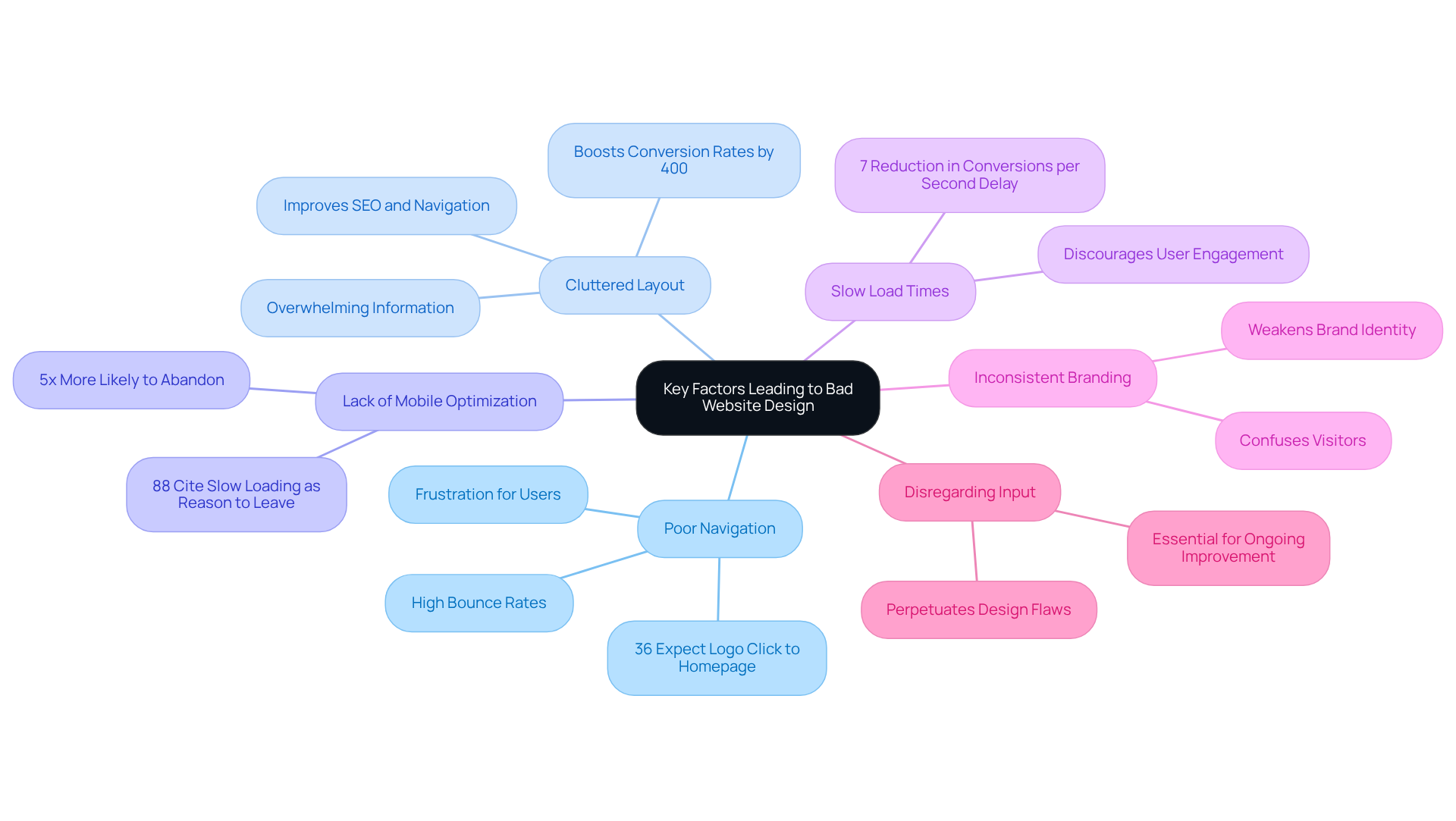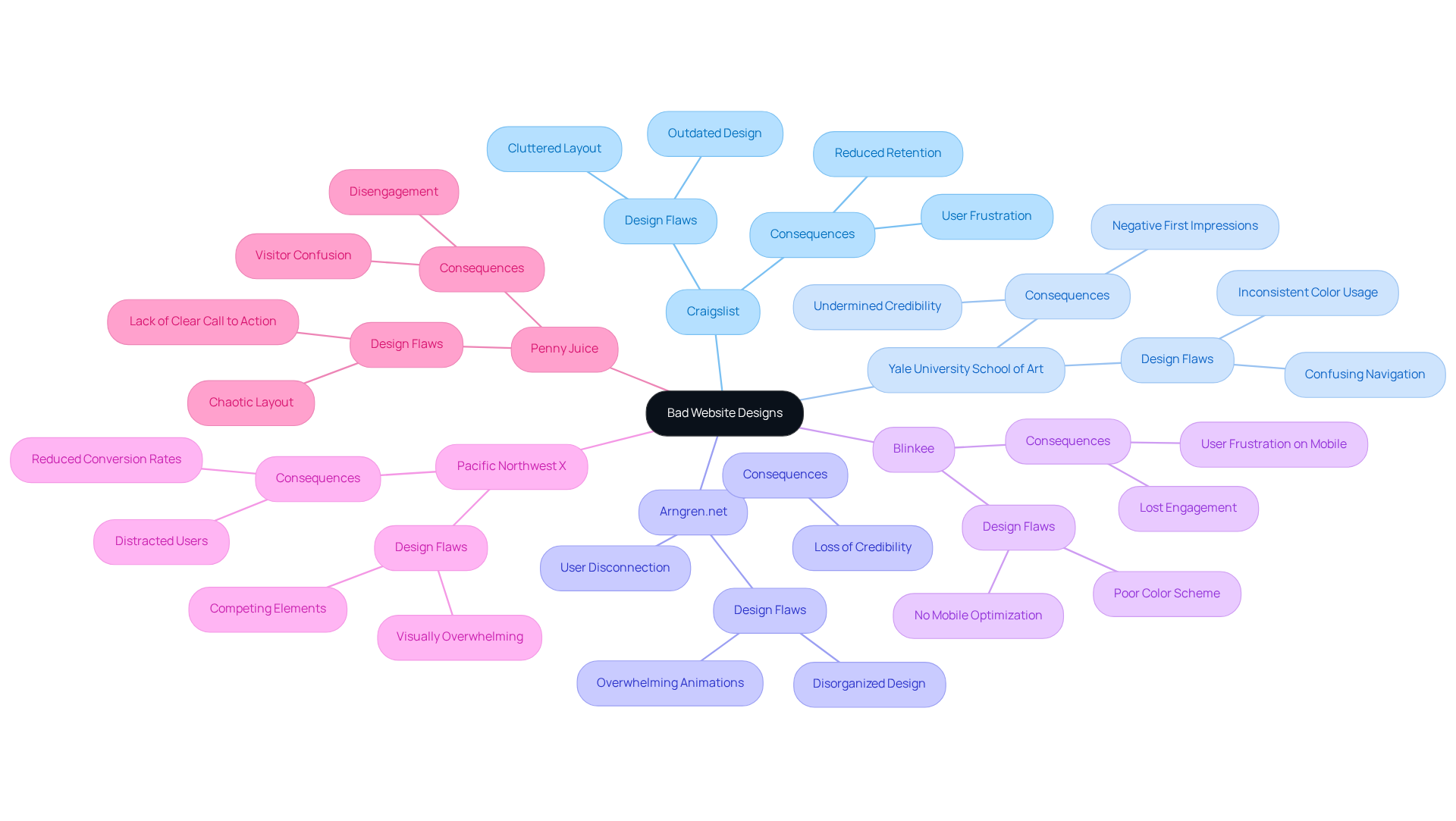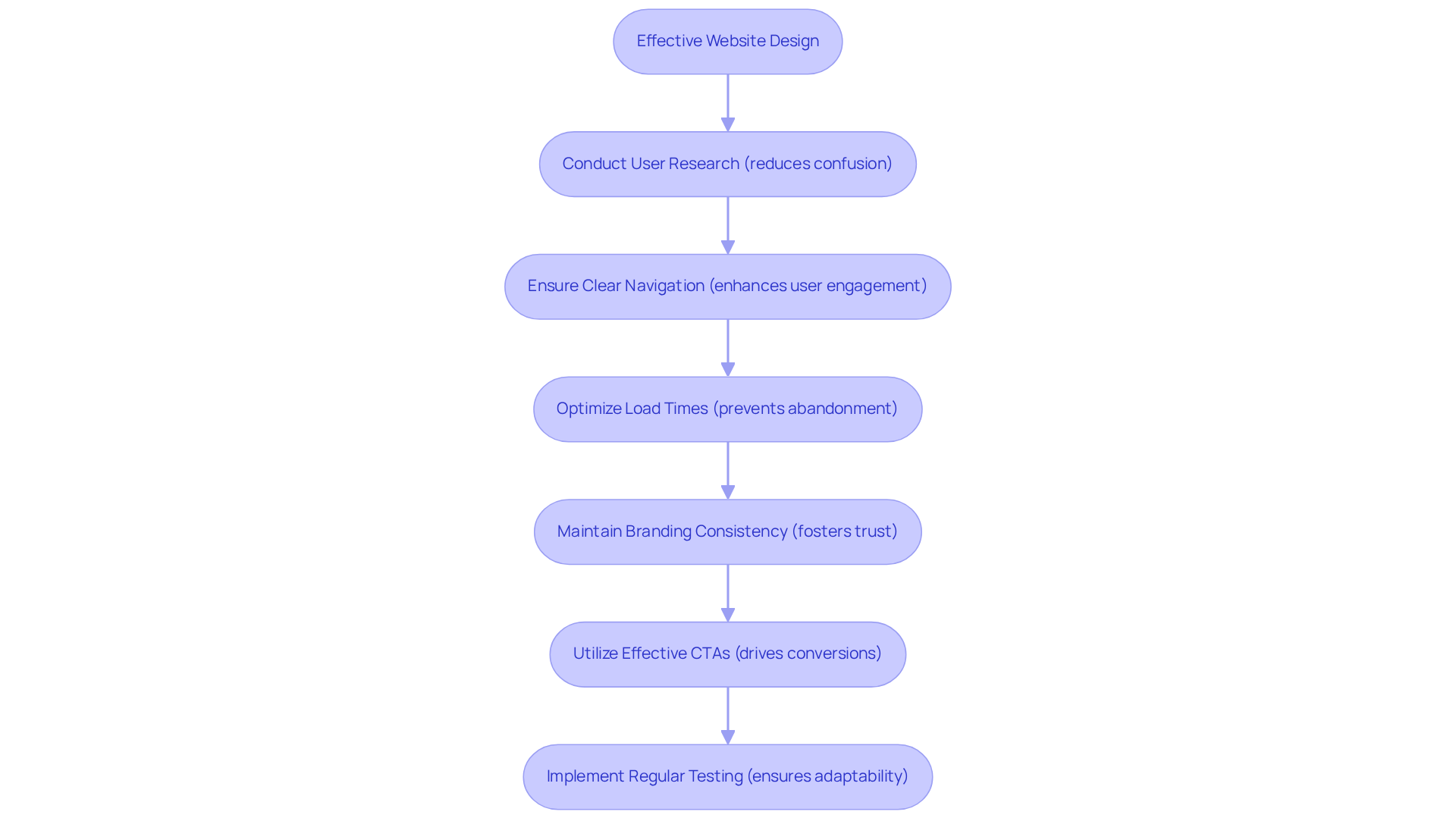Overview
This article highlights the essential website practices that tech startups should embrace, focusing on the common pitfalls that can lead to poor design. Issues like inadequate navigation, cluttered layouts, and the absence of mobile optimization can significantly impact user experience. These challenges, if left unaddressed, can hinder engagement and ultimately affect business success.
By sharing relevant statistics and examples, we emphasize the importance of tackling these issues head-on. Fortunately, with the right strategies in place, tech startups can enhance their online presence, leading to improved user satisfaction and increased growth potential.
We understand the journey of a startup founder can be daunting, but addressing these website practices can pave the way for a brighter future. Together, we can navigate these challenges and foster a supportive environment for your business to thrive.
Introduction
In the fast-paced world of tech startups, we understand that creating a compelling online presence is essential for capturing your audience's attention and fostering engagement. Yet, many new ventures often find themselves facing common design pitfalls that can not only undermine their efforts but also alienate potential customers.
This article aims to explore the vital practices that can transform your startup's website from merely functional to truly engaging. We will also highlight the significant consequences of neglecting user experience.
What challenges do you face in achieving effective design? More importantly, how can these obstacles become opportunities for growth? Together, let’s navigate this journey toward a more engaging online presence.
Identify Key Factors Leading to Bad Website Design
For tech startups, several critical factors can lead to ineffective website design, creating challenges that may feel overwhelming:
-
Poor Navigation: Imagine visiting a site where finding your way feels like a maze. Websites lacking intuitive navigation can frustrate visitors, leading to high bounce rates. Research shows that 36% of visitors expect to return to the homepage by clicking on the logo. This emphasizes the need for clear menus and logical pathways. UX designers often stress that inadequate navigation can significantly impact user experience, resulting in abandonment.
-
Cluttered Layout: Picture a page overloaded with too much information. This can easily overwhelm visitors. A clean, organized layout not only enhances readability but also fosters greater engagement. Studies indicate that a well-designed user interface can boost conversion rates by up to 400%. Additionally, effective web design improves search engine optimization (SEO) by enhancing navigation and speed.
-
Lack of Mobile Optimization: With smartphone usage continuing to rise, failing to optimize for mobile can alienate a large audience. Users are five times more likely to abandon a website that isn’t mobile-friendly, highlighting the necessity of responsive design. Furthermore, 88% of individuals consider slow loading times a primary reason for leaving mobile sites, underscoring the importance of speed in mobile optimization.
-
Slow Load Times: We all know how discouraging it can be to wait for a website to load. Research reveals that even a one-second delay can lead to a 7% reduction in conversions. This statistic emphasizes the importance of fast-loading pages in retaining visitors.
-
Inconsistent Branding: A lack of cohesive branding across your website can confuse visitors and weaken your brand identity. Consistency in colors, fonts, and messaging is crucial for establishing trust and recognition.
-
Disregarding Input: Not incorporating feedback from users can perpetuate flaws in your design. Consistent testing and iteration based on user input are essential for ongoing improvement. UX creators emphasize that understanding customer behavior is vital for crafting impactful solutions that resonate with your audience.
By addressing these common challenges, tech startups can enhance their online presence, improve visitor experience, and ultimately boost engagement and conversions. Remember, you're not alone in this journey; seeking support and guidance can make all the difference.

Examine Notable Examples of Bad Website Designs
Examining notable examples of bad design websites reveals the significant consequences of poor design choices, which can deeply affect user experience and retention.
-
Craigslist: While functional, its outdated design and cluttered layout can hinder effective navigation, leading to user frustration. Specialists highlight that 'poor UX prevents the majority of visitors from coming back to your platform,' emphasizing how vital a user-friendly design is.
-
Yale University School of Art: This platform suffers from a confusing navigation structure and inconsistent color usage, undermining its academic credibility. It's important to remember that first impressions are 94% design-related; unfortunately, this platform fails to create a positive impact.
-
Arngren.net: Often mentioned as among the least favorable online platforms, it showcases a disorganized design with overwhelming animations and an absence of concise information structure, which can estrange visitors. A visually appealing webpage unlocks credibility, and this one misses the mark, leaving users disconnected.
-
Blinkee: With a poor color scheme and no mobile optimization, this platform frustrates users on smartphones. Effective mobile UX can attract as much as 74% of visitors, but this platform does not leverage that opportunity, potentially losing out on valuable engagement.
-
Pacific Northwest X: The site is visually overwhelming, with too many competing elements that distract from the main content. Robust UX can boost your eCommerce conversion rate by as much as 400%, emphasizing the need for clarity in aesthetics to foster a positive user experience.
-
Penny Juice: This website's chaotic layout lacks a clear call to action, resulting in visitor confusion and disengagement. Research shows that 70% of online shoppers leave their carts, often due to inadequate layout decisions that could have been easily addressed.
These examples underscore the importance of following principles that prioritize user experience to prevent a bad design website. Ignoring these can lead to considerable losses in user retention and engagement, which can feel disheartening for any founder. In fact, the eCommerce sector loses around $1.420 trillion because of poor UX, highlighting the financial stakes involved in design choices. By focusing on creating a nurturing and user-friendly environment, we can turn these challenges into opportunities for growth and connection.

Implement Best Practices for Effective Website Design
Creating an effective website can feel daunting for tech startups. Many founders grapple with the challenge of meeting user expectations while ensuring their platform stands out. It’s crucial to prioritize the needs and preferences of your target audience. Conducting user research reveals that 85% of adults expect a company's mobile platform to be as good or better than its desktop version. By focusing on user experience, you can reduce project development time by up to 50%, as usability issues are detected early in the design phase.
Navigating a website should be a seamless experience, yet many visitors find themselves frustrated by complicated layouts. Clear navigation is essential—descriptive labels and a limited number of menu items can prevent overwhelming your audience. Remember, 39% of individuals will stop interacting with a site if they encounter confusion. Additionally, with 40% of users abandoning a site that takes longer than three seconds to load, clarity and speed are paramount.
In today’s digital landscape, responsive design is not just a luxury; it’s a necessity. Your online platform should cater to all devices, ensuring that visitors enjoy a consistent experience whether they’re on desktops, tablets, or smartphones. With 50% of eCommerce revenue generated from mobile devices, capturing this audience is vital.
The importance of fast load times cannot be overstated. Optimizing images and minimizing code can significantly enhance loading speeds. Studies show that 40% of users will abandon a site if it takes over three seconds to load, and even a one-second delay can lead to a 7% decrease in conversions. Speed is essential in keeping your visitors engaged and satisfied.
Branding consistency across your online presence fosters trust and recognition. Using uniform colors, fonts, and messaging strengthens your brand identity, as 75% of online credibility stems from design. This cohesive approach not only attracts visitors but also retains them.
Effective calls to action (CTAs) are your guiding lights, directing visitors toward desired actions like signing up or making a purchase. Personalized CTAs can convert 202% better than default versions, making them indispensable for driving engagement and connection.
Finally, regular testing and iteration are key to evolving your website. Continuously assess usability and gather feedback from visitors. Employing A/B testing can reveal which design elements resonate most, as companies that run these tests on their emails enjoy 37% higher conversion rates. This iterative approach ensures your website adapts to meet user needs effectively.
By embracing these best practices, you can create a website that not only meets but exceeds user expectations, fostering a nurturing environment that encourages growth and connection.

Conclusion
Tech startups find themselves at a pivotal moment where effective website design can truly shape their online identity. By recognizing and addressing the common pitfalls that often lead to poor design, these startups can transform their platforms into welcoming spaces that not only draw visitors in but also nurture engagement and retention. It's essential to focus on:
- Clear navigation
- Mobile optimization
- Fast load times
- Consistent branding
- User feedback
as these elements are crucial in crafting a website that connects with audiences and drives conversions.
In this discussion, we explored key factors that contribute to ineffective design, such as:
- Poor navigation
- Cluttered layouts
- Absence of mobile optimization
Real-world examples illustrated the tangible consequences of overlooking these aspects, showcasing how bad design can alienate users and ultimately result in significant financial setbacks. However, by embracing best practices like:
- Responsive design
- Compelling calls to action
- Regular usability testing
startups can greatly enhance user experience and satisfaction.
Ultimately, the path to effective website design is not merely about sidestepping mistakes; it's about seizing the chance to cultivate an online environment that reflects the startup's values and vision. By prioritizing user experience and adopting best practices, tech startups can elevate their digital presence and lay the foundation for enduring success in an increasingly competitive landscape. The message is clear: invest in thoughtful design, and witness how it transforms challenges into opportunities for growth and connection.
Frequently Asked Questions
What are the main factors leading to bad website design for tech startups?
The main factors include poor navigation, cluttered layout, lack of mobile optimization, slow load times, inconsistent branding, and disregarding user input.
How does poor navigation affect user experience?
Poor navigation can frustrate visitors, leading to high bounce rates. Many users expect to return to the homepage by clicking on the logo, highlighting the need for clear menus and logical pathways.
What impact does a cluttered layout have on website visitors?
A cluttered layout can overwhelm visitors, reducing readability and engagement. A clean, organized layout can significantly boost conversion rates and improve search engine optimization (SEO).
Why is mobile optimization important for websites?
Mobile optimization is crucial because users are five times more likely to abandon a website that isn’t mobile-friendly. Additionally, slow loading times are a primary reason for leaving mobile sites, making speed essential.
How do slow load times affect website conversions?
Research indicates that even a one-second delay in loading can lead to a 7% reduction in conversions, emphasizing the need for fast-loading pages to retain visitors.
What role does consistent branding play in website design?
Consistent branding helps establish trust and recognition among visitors. A lack of cohesive branding can confuse users and weaken brand identity.
Why is user feedback important in website design?
Incorporating user feedback is essential for identifying and addressing flaws in design. Consistent testing and iteration based on user input help create impactful solutions that resonate with the audience.




